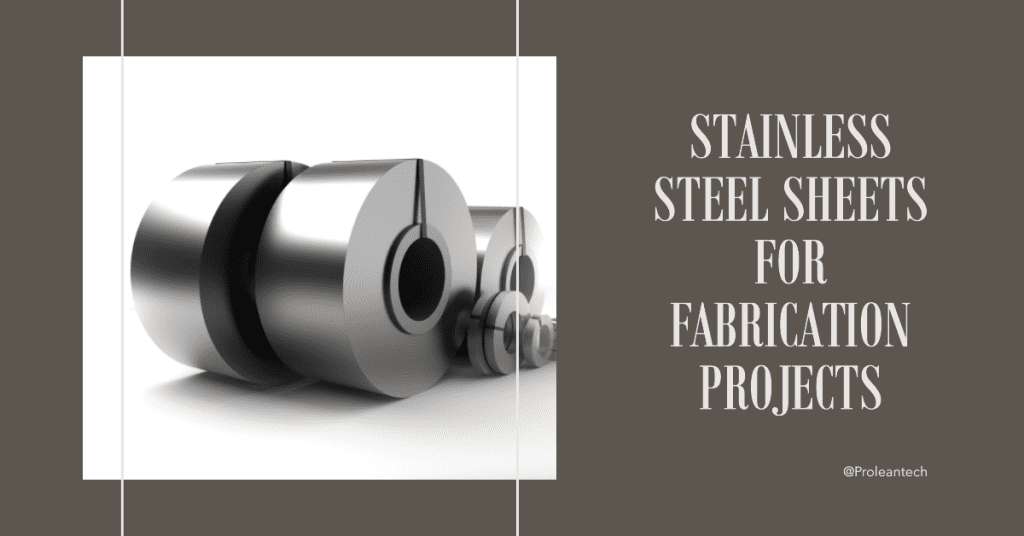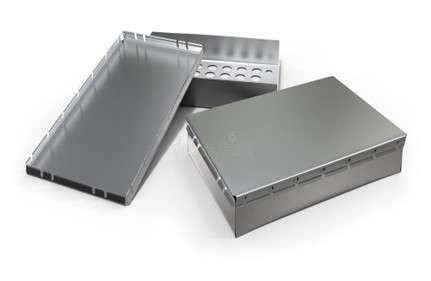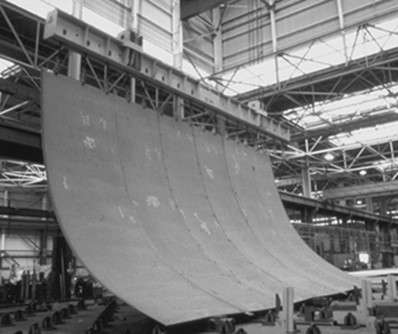
Sheet metal fabrication is one of the prominent manufacturing approaches at the current time. Various types of material sheets can be converted into desirable shapes using this technology. Stainless steel is the most common type of sheet used in sheet metal manufacturing to create a range of parts and products for many industries. It is an alloy composed of chromium, carbon, and other alloying elements. It contains 10- 12% of chromium and less than 1.2 % of carbon. The alloying by interstitial element improves the corrosion resistance of stainless steel (Schino, 2020)
It is highly compatible with all machining procedures, making any custom applications simple to process, transfer, and finish. This article will overview various grades of stainless steel sheets, their properties, advantages, fabrication compatibility, and applications.
Commonly Used Stainless Steel Sheets

Stainless steel sheets
The stainless steel sheet comes in various types with different shape grades, thicknesses, roughness, and sizes. Manufacturers use these sheets in fabrication according to the requirement of a particular application.
| Stainless Steel sheet | Description |
| Austenitic (200 combined with 300 series) |
70% of stainless steel, carbon, chromium, and nickel Weaker corrosion resistance |
| Austenitic ( 300 series, A2 or 18/8 ) |
18% of chromium and 8% nickel content. It is high-quality steel (marine grade), which is ideal for cookware & cutlery. |
| Ferritic |
10.5% to 30% of chromium & carbon less than 20% Excellent mechanical strength but less corrosion resistance. |
| Duplex |
Approximately 50% of austenite and 50 % of ferrite Lower alloy content as compared to other sheets. It has good corrosion resistance, is affordable, and is more resistant to pitting & cracking. |
| Precipitation-hardening martensitic |
Higher alloying content, such as nickel, copper, aluminum, and titanium. High strength & hardness |
While choosing the sheet metal from the above table, it is crucial to consider the requirements, the combination of manufacturing processes, and surface finishing.
It is also crucial to realize that suppliers typically offer stainless steel sheets ranging from 2500 mm to 3000 mm in length and 1250 mm to 1500 mm in width. At the same time, the thickness is between 0.4 and 4 millimeters. However, sheets of other thicknesses are also available (up to 20mm). The designer should also consider the sheet specifications before the final draft of the drawing.
Advantages of Stainless Steel Sheets
Using stainless steel sheets in fabrication projects has several benefits. It offers excellent mechanical strength, corrosion resistance, durability, recyclability, and non-porous properties.
- Excellent Strength
Stainless steel offers excellent mechanical strength. Various grades of sheets can fulfill the strength requirements for fabrication projects. For instance, the austenitic alloy is robust and can sustain heavy loads.
- Durability
Stainless steel sheets are highly corrosion resistive because of the alloying composition. It also prevents wear and tear on the surface and lasts for an extended period. Even if the operating condition has extreme moisture conditions, the correct grade of the sheet can be used to prevent corrosion and degradation. For example, 3000 series stainless steel is super resistant to corrosion.
- Recyclability
Stainless steel is a recyclable material. It can be entirely recovered after the parts and product’s life cycle. In addition, the quality of stainless steel does not degrade after the recycle. Therefore, the values remain even after use. The stainless steel sheet is compatible with a range of applications, from simple fasters to advanced aerospace parts.
- Non-porous
The non-porous materials are associated with the property of resisting liquid and air passing through the material, such as stainless steel. Any liquid or air that comes in contact with the surface remains on the surface. The non-porous property makes the stainless steel sheets suitable for trains, garden equipment, and subway to airplanes.
- High Corrosion resistance
Stainless steel is one of the engineering materials which is super resistive to corrosion & stains. This is because the amount of chromium in the alloy steel reacts with the oxygen and creates a protective oxide layer on the surface. The corrosion resistance property makes it suitable for marine & other various operating conditions.
- Formability
The sheet metal fabrication process requires a range of operations, and stainless steel is flexible with all the operations, such as cutting, forming, and joining (Nutting, 2022). Moreover, It can be shaped into complex large sized.
- Hygiene
Stainless steel makes it easy to maintain high-quality sanitary, making it suitable for kitchen wares, food & beverage processing equipment, and pharmaceutical applications.
- Fire resistance
Stainless steel sheets show the oxidation resistance property because of chromium content, which makes them resistant to fire. It is applicable in extreme thermal conditions and retains its strength and other properties.
- Aesthetic benefit
Stainless steel sheets have a brilliant silver or gray tone that gives them an excellent aesthetic look. It is suitable for residential applications since its appearance lasts long and maintains its brightness over time.
Disadvantages
There are a few downsides to using stainless steel sheets on fabrication projects. Let us take a closer look at them.
- Because stainless steel sheets are welding sensitive, rust may occur at the welding location if the surface finishing is inappropriate.
- Stainless steel reacts with highly concentrated alkaline substances and degrades the surface by cracking or etching corrosion.
- It demonstrates poor cutting performance and necessitates more advanced cutting methods, such as laser beam cutting.
Stainless steel sheets are more expensive than aluminum and other materials. Hence, short-term applications might not be more cost-effective.
Read more: Which is better aluminum or stainless steel
Try Prolean Now!
Manipulation of stainless steel sheets

Parts made with stainless steel sheets.
Stainless steel sheet is straightforward to manipulate into various shape using fabrication technology. In addition, it offers excellent machinability and weldability.
Let’s see how stainless steel works with various fabrication processes.
| Operation | Compatibility |
| Cutting | It might be challenging to cut the stainless steel sheet with shear cutting techniques, especially for thick sheets. However, the laser-cutting technique is very effective and can cut the sheet with a high degree of accuracy in a quick time. |
|
Bending
|
Bending of stainless steel sheets can be done with simple tools and manual effort. However, the CNC bending bends the sheets quickly with the correct bending angle. |
|
Riveting
|
Riveting stainless steel sheets is also possible when needed in a particular application. For example, the holes for rivets can be directly punched into the thin sheets using a punching machine. While drilling might be required for thick plates for that. |
|
Welding
|
TIG & MIG welding gives the best result for joint sheet metal pieces of stainless steel. Although, MIG gives the best control over welding operations. |
Applications
1. Energy
Stainless steel shows corrosion resistance, chemical inertness, and thermal stability, which makes the fabrication process suitable for the energy industry. Various parts and equipment of oil& gas industries are created with stainless steel sheets, such as pipelines, tanks, and pumps. It also applies to the growing renewable industries, such as wind, solar, hydropower, and geothermal.
2. Automotive & Transportation
The automotive sector heavily relies on fabricating stainless steel sheets for various parts. For example, small parts like seatbelt springs, hose clamps, and exhaust systems to the bus’s floor and hood are all created with stainless steel.
Trains and railways also use stainless steel for multiple parts, such as interiors, cargo tanks, and many more.
3. Aerospace

The turbine cover is made of stainless steel
A stainless steel sheet is used to fabricate many aerospace components, including joints in intricate structures, landing gear components, and exhaust parts. The characteristics that best meet aircraft parts’ needs include corrosion resistance, mechanical strength, thermal stability, and endurance.
4. Shipbuilding

Stainless steel in shipbuilding
Due to its high strength and outstanding corrosion resistance, marine-grade stainless steel is widely utilized in shipbuilding.
The fabrication technique is used to create a variety of ship sections, including pipelines, decks, shackles, housing for electrical components, and anchor chains.
5. Kitchen & home appliances
Stimulating stainless steel sheets are used to create enclosures for various home and kitchen appliances, including refrigerators, freezers, microwaves, washing machines, and many more. Along with other benefits, it gives these appliances long-term durability and impact resistance.
6. Construction
Fabrication of Building exteriors, interiors, movable houses, beams and columns, pins, railings, and expansion joints is very straightforward with stainless steel sheets. The high corrosion resistance and aesthetic beauty make it perfect for construction applications.
7. Food-Processing
The food processing industry also relies on the fabrication of stainless steel sheets, hygiene, easy cleaning, and other properties that make it suitable for application. For example, parts for refrigerators, cookers, grills, counters, tops, tables, sinks, and other equipment are made with stainless steel sheets.
8. Medical
Stainless steel’s biocompatibility and hygienic characteristics make it the best choice for medical applications. The austenitic grade is the commonly used stainless steel sheet for fabricating implants, stents, and various surgical devices.
Enclosures for Electronics is one of the typical applications of stainless steel, please check the article for more information.
Conclusion
Stainless steel sheets are versatile materials, which provide excellent mechanical strength, corrosion resistance, thermal stability, and fabrication flexibility. As a result, it is an ideal choice for various aerospace, automotive, food-processing construction, and other applications.
Different stainless steel grades of sheets are available for a broad range of applications. The appropriate grade type is chosen from the alternatives based on the specifications of a particular part or product. Stainless steel sheets are compatible with all fabrication operations.
Prolean offers professional stainless steel machining services for stainless steel with our advanced sheet metal fabrication technologies. Our experienced engineers & operators closely examine the requirements and create the parts for any applications. So, please send us your design and get your stainless steel parts at your door within a few days.
Related: CNC Machining: Titanium vs Steel
FAQ’s
Why stainless steel sheets are popular for fabrication projects?
Stainless steel offers high mechanical strength, thermal stability, superior corrosion resistance, fabrication flexibility, glossy silver appearance, and many other qualities. As a result, it is widely used for the fabrication of different parts for a wide range of industries.
What are the common grades of stainless steel sheets used in fabrication?
There are different sheet grades, each with a unique set of characteristics. However, Austenitic, ferritic, duplex and precipitation-hardening martensitic are frequently used alloy grades.
What are the applications of stainless steel sheets?
Stainless steel sheets are used in numerous industries, including construction, automotive, aerospace, energy, architecture, food processing, medical, and many more.
Bibliography
Nutting, J. (2022). Steel Metallurgy.
Schino, A. D. (2020, March ). Manufacturing and Applications of Stainless Steels. Metal editorial, pp. 1-2.




0 Comments